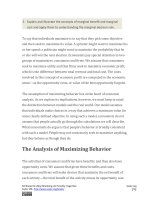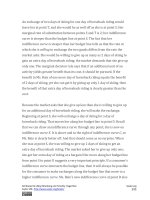Authors libby rittenberg 27
Bạn đang xem bản rút gọn của tài liệu. Xem và tải ngay bản đầy đủ của tài liệu tại đây (383.22 KB, 1 trang )
But choices in water consumption, like virtually all choices, are made at the
margin. Individuals do not make choices about whether they should or
should not consume water. Rather, they decide whether to consume a little
more or a little less water. Household water consumption in the United
States totals about 105 gallons per person per day. Think of that starting
point as the edge from which a choice at the margin in water consumption
is made. Could a higher price cause you to use less water brushing your
teeth, take shorter showers, or water your lawn less? Could a higher price
cause people to reduce their use, say, to 104 gallons per person per day?
To 103? When we examine the choice to consume water at the margin, the
notion that a higher price would reduce consumption seems much more
plausible. Prices affect our consumption of water because choices in water
consumption, like other choices, are made at the margin.
The elements of opportunity cost, maximization, and choices at the margin
can be found in each of two broad areas of economic analysis:
microeconomics and macroeconomics. Your economics course, for
example, may be designated as a “micro” or as a “macro” course. We will
look at these two areas of economic thought in the next section.
Microeconomics and Macroeconomics
The field of economics is typically divided into two broad realms:
microeconomics and macroeconomics. It is important to see the
distinctions between these broad areas of study.
Microeconomics is the branch of economics that focuses on the choices
made by individual decision-making units in the economy—typically
consumers and firms—and the impacts those choices have on individual
Attributed to Libby Rittenberg and Timothy Tregarthen
Saylor URL: />
Saylor.org
27









